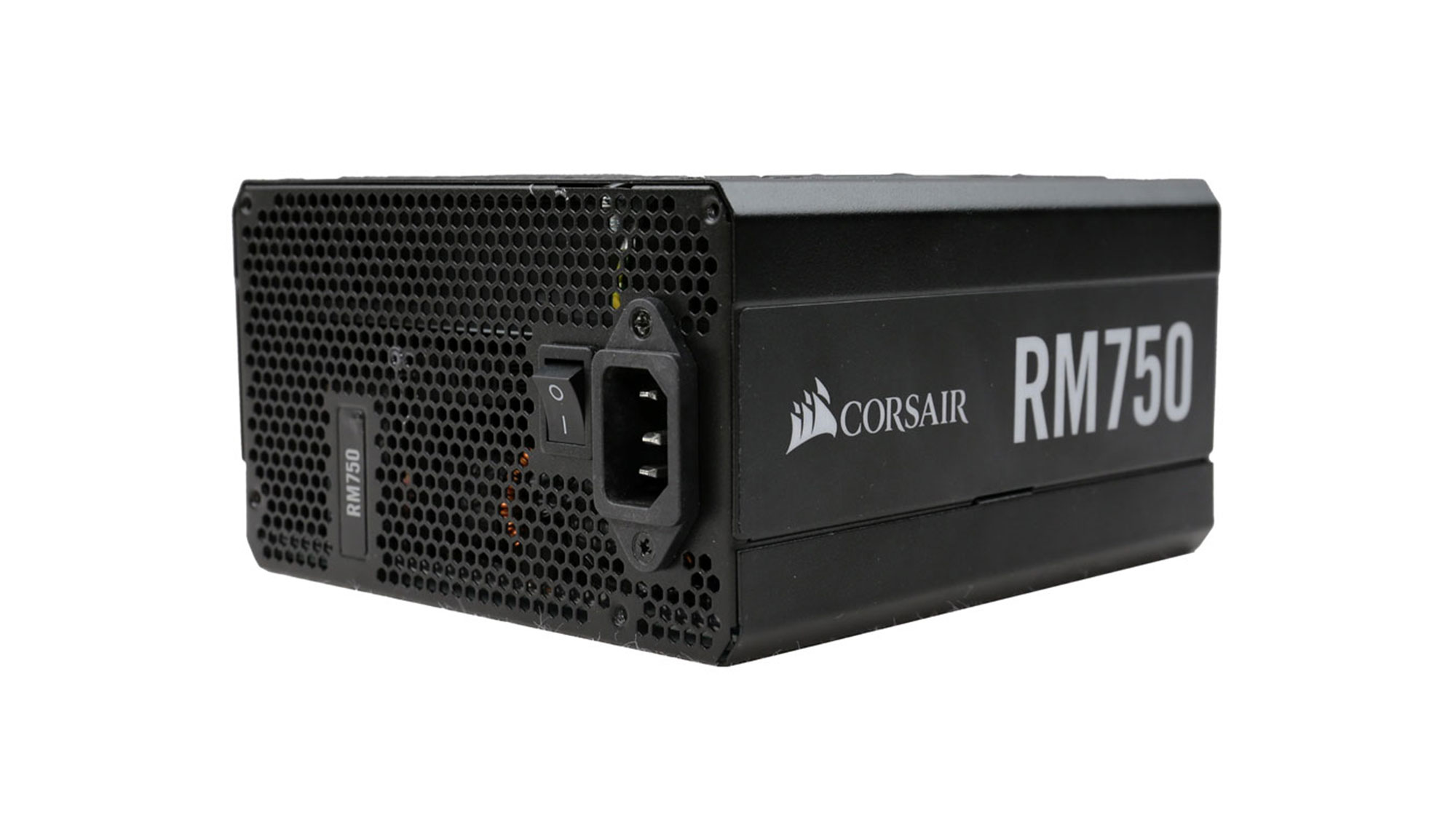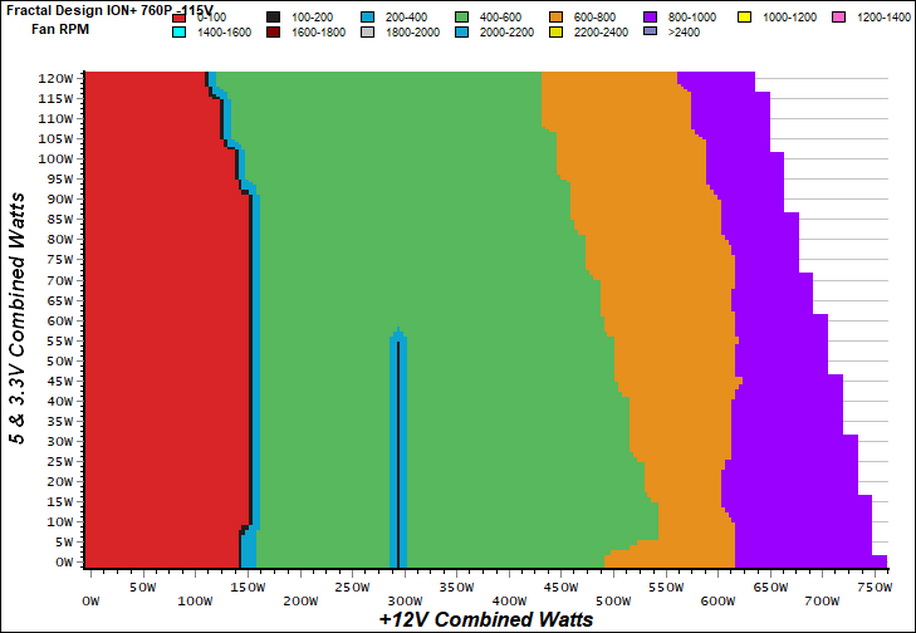Why you can trust Tom's Hardware
To learn more about our PSU tests and methodology, please check out How We Test Power Supply Units.
Primary Rails And 5VSB Load Regulation
The following charts show the main rails' voltage values recorded between a range of 40W up to the PSU's maximum specified load, along with the deviation (in percent). Tight regulation is an important consideration because it facilitates constant voltage levels despite varying loads. Tight load regulation also, among other factors, improves the system’s stability, especially under overclocked conditions and, at the same time, it applies less stress to the DC-DC converters that many system components utilize.

Results 1-8: Load Regulation





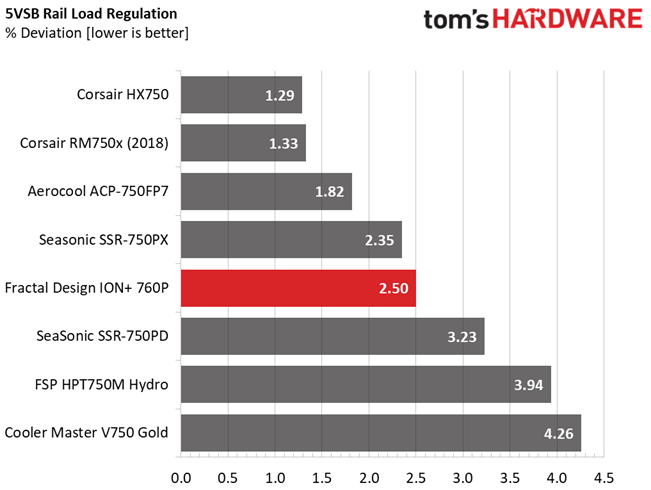

The load regulation is satisfactory on all rails.
Hold-Up Time
Put simply; hold-up time is the amount of time that the system can continue to run without shutting down or rebooting during a power interruption.

Results 9-12: Hold-Up Time





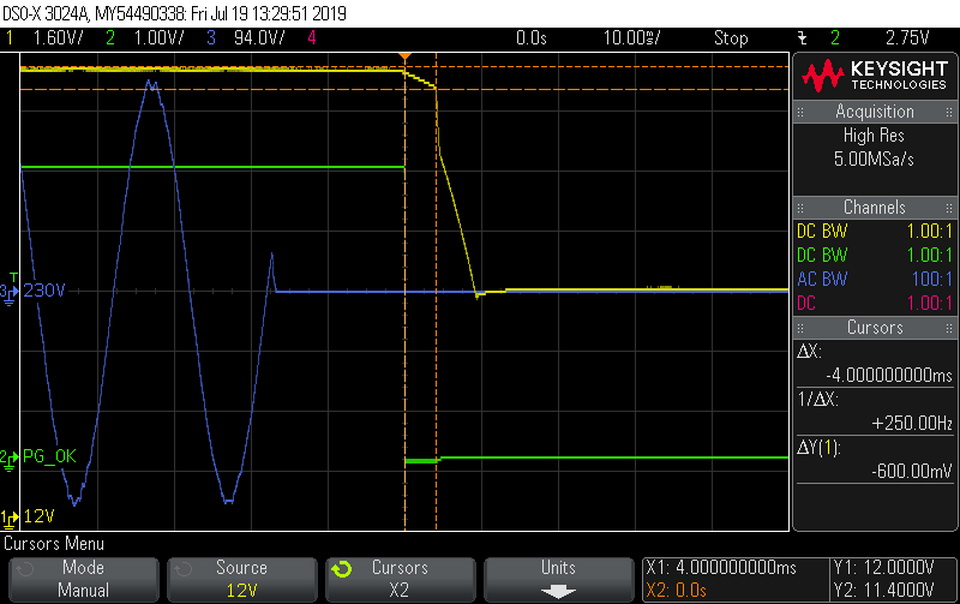
The hold-up time is longer than 21 ms, so it easily meets the minimum period that the ATX spec requires (17 ms), and the power OK signal is accurate.
Inrush Current
Inrush current, or switch-on surge, refers to the maximum, instantaneous input current drawn by an electrical device when it is first turned on. A large enough inrush current can cause circuit breakers and fuses to trip. It can also damage switches, relays, and bridge rectifiers. As a result, the lower the inrush current of a PSU right as it is turned on, the better.

Results 13-14: Inrush Current

The inrush current is low with 115V and on the high side with 230V. Still, it is notably below 100A, so it won't cause any problems.
Get Tom's Hardware's best news and in-depth reviews, straight to your inbox.
10-110% Load Tests
These tests reveal the PSU's load regulation and efficiency levels under high ambient temperatures. They also show how the fan speed profile behaves under increased operating temperatures.
| Test # | 12V | 5V | 3.3V | 5VSB | DC/AC (Watts) | Efficiency | Fan Speed (RPM) | PSU Noise (dB[A]) | Temps (In/Out) | PF/AC Volts |
| 1 | 4.490A | 1.991A | 1.993A | 1.002A | 76.156 | 88.142% | 0 | <6.0 | 45.81°C | 0.959 |
| 12.148V | 5.026V | 3.312V | 4.993V | 86.401 | 40.24°C | 115.12V | ||||
| 2 | 9.964A | 2.985A | 2.993A | 1.204A | 151.854 | 91.588% | 0 | <6.0 | 46.82°C | 0.984 |
| 12.139V | 5.024V | 3.308V | 4.986V | 165.802 | 40.62°C | 115.12V | ||||
| 3 | 15.807A | 3.486A | 3.479A | 1.406A | 227.752 | 92.725% | 0 | <6.0 | 47.74°C | 0.994 |
| 12.130V | 5.023V | 3.306V | 4.979V | 245.621 | 41.35°C | 115.11V | ||||
| 4 | 21.663A | 3.985A | 3.993A | 1.610A | 303.762 | 92.467% | 478 | 7.8 | 41.65°C | 0.996 |
| 12.120V | 5.022V | 3.304V | 4.970V | 328.507 | 48.52°C | 115.11V | ||||
| 5 | 27.230A | 4.907A | 5.001A | 1.815A | 379.887 | 92.200% | 489 | 8.1 | 42.30°C | 0.997 |
| 12.110V | 5.018V | 3.300V | 4.961V | 412.027 | 49.45°C | 115.11V | ||||
| 6 | 32.741A | 5.984A | 6.006A | 2.020A | 456.015 | 91.574% | 555 | 9.9 | 42.54°C | 0.998 |
| 12.101V | 5.016V | 3.296V | 4.953V | 497.976 | 50.27°C | 115.11V | ||||
| 7 | 38.255A | 6.985A | 7.018A | 2.226A | 531.742 | 91.064% | 600 | 11.9 | 43.36°C | 0.998 |
| 12.093V | 5.013V | 3.292V | 4.944V | 583.922 | 51.40°C | 115.11V | ||||
| 8 | 43.849A | 7.990A | 8.032A | 2.433A | 608.258 | 90.457% | 756 | 18.5 | 43.92°C | 0.998 |
| 12.083V | 5.009V | 3.287V | 4.935V | 672.427 | 52.90°C | 115.10V | ||||
| 9 | 49.777A | 8.491A | 8.523A | 2.433A | 683.585 | 89.878% | 933 | 25.3 | 44.15°C | 0.999 |
| 12.075V | 5.008V | 3.285V | 4.935V | 760.574 | 53.51°C | 115.10V | ||||
| 10 | 55.551A | 8.999A | 9.051A | 3.058A | 760.010 | 89.165% | 1046 | 29.0 | 45.08°C | 0.999 |
| 12.066V | 5.003V | 3.282V | 4.907V | 852.363 | 54.81°C | 115.10V | ||||
| 11 | 61.897A | 9.003A | 9.064A | 3.061A | 836.037 | 88.541% | 1336 | 36.2 | 46.52°C | 0.999 |
| 12.057V | 5.001V | 3.278V | 4.903V | 944.232 | 57.01°C | 115.10V | ||||
| CL1 | 0.154A | 14.003A | 14.000A | 0.000A | 118.180 | 84.237% | 0 | <6.0 | 49.53°C | 0.981 |
| 12.125V | 5.018V | 3.289V | 5.064V | 140.295 | 42.56°C | 115.12V | ||||
| CL2 | 63.354A | 1.004A | 1.001A | 1.000A | 778.434 | 89.727% | 1321 | 35.8 | 45.35°C | 0.999 |
| 12.077V | 5.014V | 3.296V | 4.974V | 867.558 | 54.46°C | 115.10V |
The PSU can operate without any problems under high operating temperatures, even with higher than its nominal capacity, loads. Moreover, the APFC converter is tuned correctly, so the PF readings are high throughout the entire load range that we dialed.
20-80W Load Tests
In the following tests, we measure the PSU's efficiency at loads significantly lower than 10% of its maximum capacity (the lowest load the 80 PLUS standard measures). This is important for representing when a PC is idle with power-saving features turned on.
| Test # | 12V | 5V | 3.3V | 5VSB | DC/AC (Watts) | Efficiency | Fan Speed (RPM) | PSU Noise (dB[A]) | PF/AC Volts |
| 1 | 1.191A | 0.496A | 0.481A | 0.199A | 19.618 | 49.207% | 0 | <6.0 | 0.894 |
| 12.194V | 5.039V | 3.315V | 5.033V | 39.868 | 115.11V | ||||
| 2 | 2.448A | 0.993A | 0.997A | 0.399A | 40.060 | 81.875% | 0 | <6.0 | 0.916 |
| 12.155V | 5.035V | 3.311V | 5.022V | 48.928 | 115.12V | ||||
| 3 | 3.632A | 1.491A | 1.480A | 0.599A | 59.527 | 86.356% | 0 | <6.0 | 0.940 |
| 12.151V | 5.030V | 3.306V | 5.011V | 68.932 | 115.12V | ||||
| 4 | 4.886A | 1.991A | 1.992A | 0.800A | 79.954 | 88.592% | 0 | <6.0 | 0.962 |
| 12.147V | 5.026V | 3.312V | 5.000V | 90.250 | 115.12V |
The efficiency with 20W load is very low. It is even lower than the level that the Ion+ 860P achieved. On the contrary, the efficiency is high on the other three tests that we conducted.
2% or 10W Load Test
Intel plans on raising the ante at efficiency levels under ultra-light loads. So from July 2020, the ATX spec will require 70% and higher efficiency with 115V input. The applied load is only 10W for PSUs with 500W and lower capacities, while for stronger units we dial 2% of their max-rated-capacity.
| Test # | 12V | 5V | 3.3V | 5VSB | DC/AC (Watts) | Efficiency | Fan Speed (RPM) | PSU Noise (dB[A]) | PF/AC Volts |
| 1 | 1.088A | 0.247A | 0.246A | 0.051A | 15.570 | 44.135% | 0 | <6.0 | 0.878 |
| 12.180V | 5.042V | 3.315V | 5.041V | 35.278 | 115.11V |
The efficiency with 2% load is disappointing. High Power should fix this if it wants this platform to meet the requirements of the newer ATX spec.
Efficiency
Next, we plotted a chart showing the PSU’s efficiency at low loads, and loads from 10 to 110% of its maximum-rated capacity. The higher a PSU’s efficiency, the less energy goes wasted, leading to a reduced carbon footprint and lower electricity bills.

Results 15-18: Efficiency
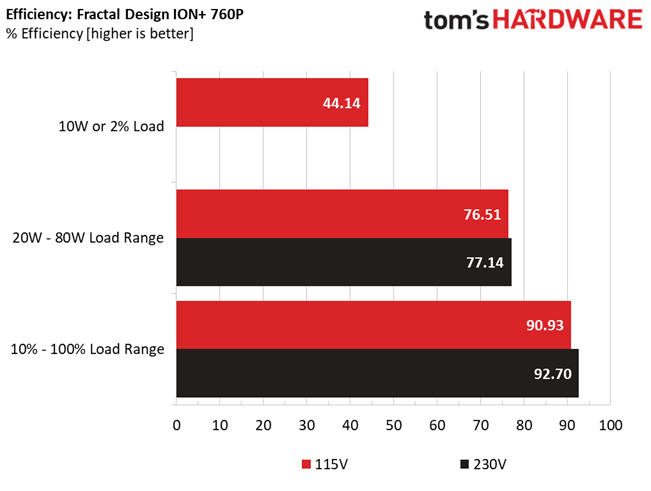



With normal loads, the overall efficiency is high. This is not the case, though, with light and super light loads.
5VSB Efficiency
| Test # | 5VSB | DC/AC (Watts) | Efficiency | PF/AC Volts |
| 1 | 0.100A | 0.512 | 68.725% | 0.100 |
| 5.112V | 0.745 | 115.09V | ||
| 2 | 0.250A | 1.277 | 74.810% | 0.200 |
| 5.105V | 1.707 | 115.09V | ||
| 3 | 0.550A | 2.801 | 76.426% | 0.316 |
| 5.091V | 3.665 | 115.10V | ||
| 4 | 1.000A | 5.072 | 77.082% | 0.392 |
| 5.071V | 6.580 | 115.10V | ||
| 5 | 1.500A | 7.573 | 77.307% | 0.432 |
| 5.048V | 9.796 | 115.10V | ||
| 6 | 3.000A | 14.927 | 76.828% | 0.481 |
| 4.975V | 19.429 | 115.10V |
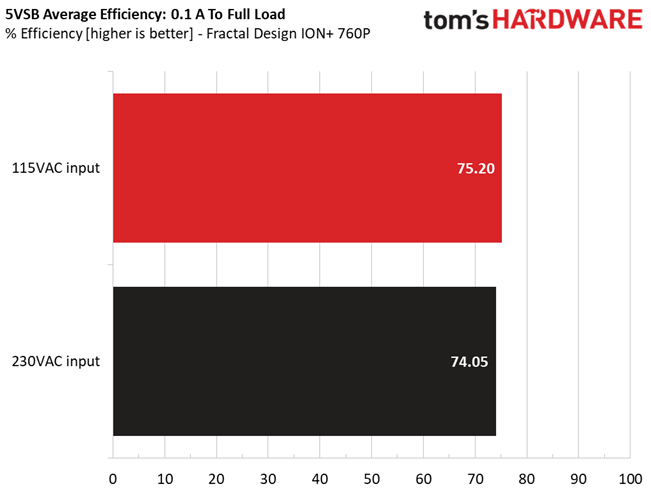
Results 19-20: 5VSB Efficiency
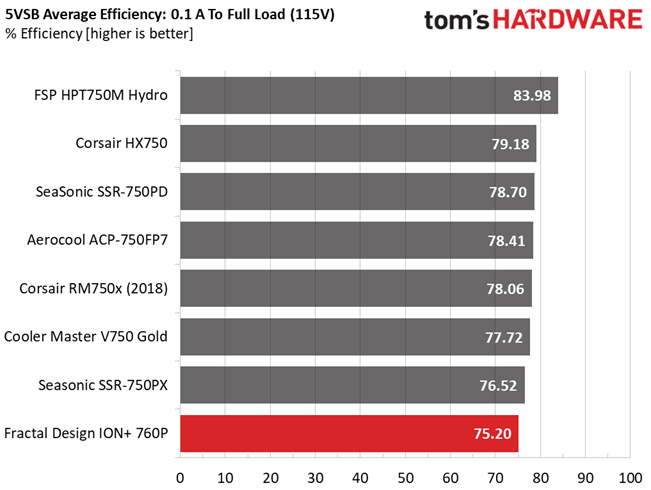
The 5VSB rail is not efficient, and this is not acceptable in a modern platform like this one.
Power Consumption In Idle And Standby
| Mode | 12V | 5V | 3.3V | 5VSB | Watts | PF/AC Volts |
| Idle | 12.193V | 5.056V | 3.316V | 5.055V | 6.241 | 0.443 |
| 115.1V | ||||||
| Standby | 0.102 | 0.013 | ||||
| 115.1V |

Results 21-22: Vampire Power

The energy needs of the PSU at standby mode are increased. This affects, of course, the efficiency of the 5VSB rail at light loads.
Fan RPM, Delta Temperature, And Output Noise
All results are obtained between an ambient temperature of 37 to 47 degrees Celsius (98.6 to 116.6 degrees Fahrenheit).
The fan profile is relaxed, even at high operating temperatures.
The following results were obtained at 30 to 32 degrees Celsius (86 to 89.6 degrees Fahrenheit) ambient temperature.
The passive operation doesn't last long, but the fan speeds don't exceed 1000RPM, even in the worst-case scenario.
MORE: Best Power Supplies
MORE: How We Test Power Supplies
MORE: All Power Supply Content
Current page: Load Regulation, Hold-Up Time, Inrush Current, Efficiency and Noise
Prev Page Specifications and Part Analysis Next Page Protection Features, DC Power Sequencing, Cross-Load Tests and Infrared Images
Aris Mpitziopoulos is a contributing editor at Tom's Hardware, covering PSUs.
-
shadyj Reply
Hello,Admin said:The Ion+ 760P from Fractal Design offers good performance and silent operation at a decent price.
Fractal Design Ion+ Platinum 760W Power Supply Review : Read more
I just want to thank Tom's Hardware for such in-depth PSU reviews like this with serious measurements. I will admit most of the metrics in the review go over my head, but the reviewer does provide guidance as to how those measurements rank the product under review. I know this is not easy to do since I review products that have measurable performance that can get highly technical, but I try to provide commentary as to the meaning of the test results. These objective results are so much more valuable than some "influencer's" subjective experience on youtube or some other low data review. This really helps us who aren't electrical engineers make a slightly more informed purchase with more confidence.
Thanks! -
NoFaultius Interesting timing on your article. I just RMA'd this power supply today. It worked great for 10 months, then started causing random reboots. While it worked, it worked great. Silent and strong. So far, they have been good with the RMA process. They emailed me a label to send them the defective unit back. Apparently they will send me a replacement once they get it and run some tests.Reply

